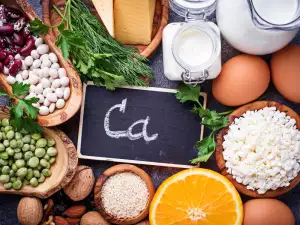Calcium is one of the most abundant minerals in the human body. It accounts for approximately 1.5% of our total body weight. Bones and teeth contain 99% of the total amount of calcium in the body. The human body can not produce calcium, so to keep the normal amount of calcium in the body, one has to turn to their diet. Everyone loses calcium every day through their urine, sweat, skin, hair and nails. Many nutrition experts recommend that adults take between 1000 and 1300 mg of this substance daily.
Functions of calcium
Calcium is best known for its role in maintaining the strength and density of bones. In a process known as bone mineralization, calcium and phosphorus join to form calcium phosphate.
Calcium phosphate is a major component of the mineral complex called hydroxyapatite, which provides the structure and composition of bone. Calcium also plays a role in many physiological activities that are not related to bones, including blood clotting, nerve conduction, muscle contraction, regulation of enzyme activity and cell membrane function.
Transmission of nerve impulses in the body takes place due to electrical activity in the body, which leads to the opening and closing of the gates of cell membranes. When these peculiar doors open, they allow some ions /such as potassium and sodium/ to pass through the cells. This movement of ions causes electrical impulses that send nerve signals. Calcium helps to control the opening and closing of those doors that allow the entry of potassium. Without sufficient calcium, potassium channels that can’t be opened and closed properly, resulting in impaired nerve signaling.
Calcium is one of the clotting factors. Blood clotting is a process during which it produces means of preventing dangerous and excessive bleeding. When a blood vessel is damaged, platelets gather in this place, to stop the bleeding. Clumping trombotsite is performed by clotting factors that help to keep them glued together. As seen, calcium is one of these important factors.

Calcium deficiency
Insufficient calcium intake, poor absorption, or lose through urine and faeces can lead to calcium deficiency. In children, calcium deficiency can lead to impaired bone mineralization, leading to rickets - a condition characterized by bone deformities and growth retardation. In adults, calcium deficiency can lead to osteomalacia or softening of the bones. If the intake of calcium intake is too low to maintain normal blood levels, your body will rely on the storage of calcium in bones to maintain normal blood concentrations, and after years can lead to osteoporosis.
Low levels of calcium in the blood (especially one particular form of calcium called free ionized calcium) can cause a condition called tetany. Symptoms of tetany include muscle pain and spasms, and numbness in hands and feet.
Lack of stomach acid violates calcium absorption and can lead to calcium deficiency. Adequate intake of vitamin D is necessary for the absorption and utilization of calcium. As a result of vitamin D deficiency, or impaired conversion of inactive to the active form of vitamin D, which is made in the liver and kidneys, can also lead to calcium deficiency.
Overdose with calcium
Excessive intake of calcium (more than 3000 mg per day) can lead to increased blood levels of calcium, a condition known as hypercalcemia. If blood levels of phosphorus are low at the same time, hypercalcemia can lead to calcification of soft tissues. Overdose of calcium can lead to arrhythmias.
Absorption of calcium
The following drugs and substances affect the absorption, utilization and excretion of calcium, like physiological corticosteroids, aluminum-containing antacids, thyroid hormones, anticonvulsant drugs, some antibiotics, hormone replacement therapy, vitamin D, and a high potassium level, high intake of sodium, caffeine or protein, certain types of dietary fiber, phytic acid contained in cereals, nuts and legumes, oxalic acid contained in spinach, beets, celery, peanuts, tea and cocoa.
Benefits of Calcium
Calcium may play a role in the prevention and/or treatment of the following diseases: cataracts, colon cancer, high blood pressure, inflammatory bowel disease, kidney stones, osteoporosis syndrome, polycystic ovary hypertension induced in pregnancy, and more.
A normal heartbeat is provided by a series of muscle contractions to occur in the correct sequence. These muscle contractions are controlled by electrically pulses /in turn operated from the electrolyte to the positive or negative charge/. Calcium has a positive charge. It is one of the main and most important electrolytes in the body. The positive charge helps calcium to signal muscles for contraction and relaxation, so that the heart keeps beating normally.
Foods rich in calcium
Excellent source of calcium include: spinach, green turnip, green horseradish. Good sources of calcium include: low-grade molasses, yogurt, cabbage, cheese, mozzarella, goat milk and cow milk, thyme, fennel, cinnamon, leaves of mint. Other good sources of calcium include: lettuce, celery, broccoli, sesame seeds, summer squash, green beans, garlic, Brussels sprouts, oranges, asparagus, mushrooms, oregano, rosemary, parsley. The amount of calcium in the diet remains unchanged in cooking or after long storage.

















Comments